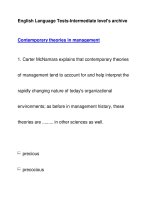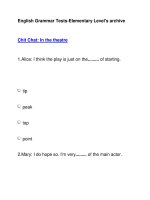increasing pvengineering’s quality performance in design engineering
Bạn đang xem bản rút gọn của tài liệu. Xem và tải ngay bản đầy đủ của tài liệu tại đây (672.45 KB, 50 trang )
HO CHI MINH CITY OPEN UNIVERSITY
UNIVERSITÉ LIBRE DE BRUXELLES
SOLVAY BRUSSELS SCHOOL OF
ECONOMICS & MANAGEMENT
MBQPM5
NGUYEN NGOC HUYNH
INCREASING PVENGINEERING’s QUALITY
PERFORMANCE IN DESIGN ENGINEERING
MASTER FINAL PROJECT
MASTER IN BUSINESS QUALITY AND PERFORMANCE MANAGEMENT
Ho Chi Minh City
(2016)
Master Final Project
STATEMENT OF AUTHENTICATION
I hereby declare that the master final report titled “Increasing PV Engineering’s quality
performance in design engineering” is my own work and has not been submitted for a
degree or diploma in any university. I have acknowledged all source materials in the work
itself. The materials, either in full or in part, are duly acknowledged/ referred in the text.
HoChiMinh City, 23rd April, 2016
Signature of Student
Nguyen Ngoc Huynh
Increasing PV Engineering’s Quality Performance In Design Engineering
i
Master Final Project
ACKNOWLEDGMENTS
I would like to express my special thanks of gratitude to my tutor, Prof. Jacques Martin as
well as my company/ department (PV Engineering/ Project Management Department)
who gave me the opportunity to do this wonderful project on the topic “Increasing PV
Engineering’s quality performance in design engineering”, which also helped me in
doing a lot of Research and orientate the right direction.
Secondly I would also like to thank my friends who helped me a lot in finalizing this
report within the limited time frame and had a lot of supports such as the necessary and
helpful ideas for contents and structure.
Next, I would also like to thank the experts, co-workers who were involved in the survey
for this research project and from engineering disciplines. Without their passionate
participation and input, the survey could not have been successfully conducted.
Finally, I must express my very profound gratitude to my parents and to my husband for
providing me with support and continuous encouragement throughout my years of study
and through the process of researching and writing this thesis. This accomplishment
would not have been possible without them.
Thank you so much.
Increasing PV Engineering’s Quality Performance In Design Engineering
ii
ACCEPTANCE OF FINAL PROJECT REPORT FOR DEFENSE
Mr/Ms NGUYEN NGOC HUYNH’s final project report for the degree of Master in
Business Quality and Performance Management is officially accepted for defense.
On 13 April 2016
Dr. Jacques M.A. Martin
Academic Director
Master in Business Quality and Performance Management
Solvay Brussels School of Economics and Management – Ho Chi Minh City Open University
Master Final Project
TABLE OF CONTENTS
INTRODUCTION .................................................................................................................................... 1
1. Introduction To PVEngineering .................................................................................................. 1
2. PV Engineering’s Problem ........................................................................................................... 3
3. Purpose of Master Final Report .................................................................................................. 3
4. Structure Of Report ...................................................................................................................... 3
PART 1: CURRENT QUALITY PERFORMANCEAT PVE’s DESIGN ENGINEERING ........ 4
CHAPTER 1: MANAGEMENT STRUCTURE ..................................................................................... 4
1. Organization Culture And Strategic Management In PV Engineering ................................. 4
2. Working Environment And Job Design ..................................................................................... 8
CHAPTER 2: ANALYSIS OF DESIGN ENGINEERING PROCESS ................................................ 11
1. Selection of Research Strategy ................................................................................................... 11
2. Data Collection Methods ............................................................................................................. 11
3. Data Analysis Methods ................................................................................................................ 13
PART 2: EVALUATION OF PERFORMANCE ............................................................................. 14
CHAPTER 1: RESULTS - FINDINGS .................................................................................................. 14
Key Findings: .................................................................................................................................... 14
1. Roles And Tasks of Disciplines In Quality Management ....................................................... 15
2. Strategy ......................................................................................................................................... 16
3. Key Success Factors ..................................................................................................................... 17
4. Innovation ..................................................................................................................................... 17
5. Information Systems And Network ........................................................................................... 18
6. Performance Management System ............................................................................................ 18
CHAPTER 2: PROPOSED IMPROVEMENT FOR INCREASING QUALITY PERFORMANCE 20
1. Roles And Tasks of Disciplines In Quality Management ....................................................... 20
2. Strategy ......................................................................................................................................... 21
3. Key Success Factors ..................................................................................................................... 21
4. Innovation ..................................................................................................................................... 23
5. Information Systems And Network ........................................................................................... 23
6. Performance Management System ............................................................................................ 24
DISCUSSION ......................................................................................................................................... 28
CONCLUSION ....................................................................................................................................... 30
Increasing PV Engineering’s Quality Performance In Design Engineering
iv
Master Final Project
LIST OF ABBREVIATIONS
PVE
: PetroVietnam Engineering Join Stock Company
LPG
: Liquefied petroleum gas
CNG
: Compressed natural gas
EPC
: Engineering, Procurement and Construction
FS
: Feasibility Study
FEED
: Front – End Engineering Design
PVE-SC
: PVE – Survey Consultancy Joint Stock Company
PVE-PMC
: PVE – Project Management Consultancy Joint Stock Company
PVE-PCIC
:
HR
: Human Resource
EPC
: Engineering – Procurement – Construction
FPSO
: Floating Production, Storage and Offloading
FSO
: Floating, Storage & Offloading
GEO
: Geological
ASEAN
: Association of Southeast Asian Nations
APEC
: Asia-Pacific Economic Cooperation
WTO
: World Trade Organization
TPP
: Trans-Pacific Partnership
PDCA
: Plan – Do – Check – Act
KPIs
: Key Performance Indicators
ERP
: Enterprise Resources Planning
PVE – PetroVietnam Construction Investment Consultancy Joint Stock
Company
Increasing PV Engineering’s Quality Performance In Design Engineering
v
Master Final Project
LIST OF FIGURES AND TABLES
List of figures
Figure 1: PVE’s organizational structure
Figure 2: Elements of organizational culture
Figure 3: Strategies for strengthening organizational culture
Figure 4: PV Engineering’ strategy map
Figure 5: Workplace factors affecting employee performance
Figure 6: Results of Interviews on Knowledge of Quality Management System
Figure 7: Percentage of staffs complying with Quality Management System
Figure 8: PDCA – based on Performance Management System
List of Tables
Table 1:
Success factor datasheet
Increasing PV Engineering’s Quality Performance In Design Engineering
vi
Master Final Project
INTRODUCTION
1.
INTRODUCTION TO PV ENGINEERING
Vietnam is rich in natural resources and minerals which are favorable conditions for
strongly growing economic development of the country, especially Vietnam Oil &
Gas sector. To contribute to the development of Vietnam Oil & Gas Group,
PetroVietnam Engineering (PVE) has the important roles in the Engineering design
and consultancy for the Group’s projects.
PVE‘s predecessor was established, and began operation in 1998. With gradually
consistent development, PVE has developed subsidiaries and specialized centers
which are suitable to the sustainable operation of the company for the foreseeable
future. PVE became a joint stock company in 2005 and has participated in Oil and gas
exploration and development projects, gas processing and transportation; and also
provided services for projects in petroleum storage, LPG/ CNG stations and other key
projects in power plants, industrial. Until now, PVE has the organizational structure as
the below figure to operate the corporation and complete the projects and works
within PVE’s mission, such as Engineering Consultancy, EPC/ Construction/
Installation, Project Management Consultancy, and Survey & Inspection. Until now,
PVE has successfully completed many major projects with Petro Vietnam and other
international partners such as Nam Con Son 2 Pipeline, Su Tu Trang Platform, Dai
Hung Gas gathering project, etc.; and PVE is one of the top providers for professional
engineering consulting services in the petroleum industry from upstream to
downstream, power projects, other industry and civil projects in Vietnam. Moreover,
in the future, PVE will be your constant and closest companion not only in the
projects of oil and gas industry and other related projects as: Onshore, Offshore; Gas
Pipeline; Gas Processing Plant; Petrochemical Plant (such as polypropylene, fertilizer
plants); Gas power, coal power; wind power and hydropower plants; Bio-Ethanol
plants; but also in industrial and civil projects and will provide expert services in: FS;
FEED, detailed engineering; General cost estimation; Procurement support; Survey
and inspection; Project management consultancy.
Increasing PV Engineering’s Quality Performance In Design Engineering
Page 1 of 30
Master Final Project
Figure 1: PVE’s organizational structure (Source: PVE’s website)
Shareholders
General Assembly
Supervisory Board
Board of Management
Board of Director
Human
Resources
Division
Financial
Division
Planning &
Investment
Division
Economic &
Technical
Division
Office
PVE-PMC
Increasing PV Engineering’s Quality Performance In Design Engineering
PVE-SC
Commercial
& Contract
Division
Design Engineering
Consultancy Center
(DEC)
PCIC
Page 2 of 30
Master Final Project
2.
PV ENGINEERING’s PROBLEM
Nowadays, Vietnam participates in many international organizations such as ASEAN,
APEC, WTO and TPP. It is the mark for success of Vietnam’s development and
efforts in global economy. Besides that, it means there is strictly international and
national competitive environment that will bring increased demands on the
organizations competiveness and customers. One of the most important management
conditions to make the branch and performance of business is quality that is an
important management philosophy, which supports the organizations in their efforts to
obtain satisfied customers. However, quality management is not fully implemented
and complied with PVE’s regulations, ways how to deal with customers, etc. Finally,
traditional work practice and management attitudes do not conform to total quality
management, which causes a resistance towards an implementation of total quality
management, especially in Design Engineering of PVE.
3.
PURPOSE OF MASTER FINAL REPORT
The aim of report is to study the role and tasks of Design Engineering Departments in
regard to implementing the Quality Management and to propose methods to increase
the performance in design engineering.
4.
STRUCTURE OF REPORT
INTRODUCTION
Part 1: CURRENT QUALITY PERFORMANCE AT PVE’s DESIGN
ENGINEERING
Chapter 1: Management Structure
Chapter 2: Analysis of Design Engineering Process
Part 2: EVALUATION OF PERFORMANCE
Chapter 1: Results – Findings
Chapter 2: Proposed Improvement for Increasing Quality Performance
DISCUSSION
CONCLUSION
Increasing PV Engineering’s Quality Performance In Design Engineering
Page 3 of 30
Master Final Project
PART 1:CURRENT QUALITY PERFORMANCEAT
PVE’s DESIGN ENGINEERING
CHAPTER 1: MANAGEMENT STRUCTURE
1.
ORGANIZATION CULTURE AND STRATEGIC MANAGEMENT IN
PVENGINEERING
1.1. PV Engineering’s Mission and Vision
As our mission, PV Engineering will
- Be the professional design consultant contractor in oil and gas field,
- Provide the products and services in design consultancy, survey consultancy,
project management consultancy, high technical services in oil & gas field and
other industries with high quality and competitive prices to meet needs of
customers from PVN’s members and customers from other industrial fields;
- Ensure the benefits of stakeholders, and
- Contribute to the industrialization and modernization of Vietnam
And in the future, PV Engineering will:
- Be one of the leading companies in Vietnam and Southeast Asia with key
business areas (such as design consultancy, survey consultancy, project
management consultancy, high technical services in oil & gas field and other
industries);
- Have enough competitive power with local companies and international
companies in Vietnam; while expanding service oversea.
1.2. Organization Culture
Organizational culture includes the basic pattern of shared assumptions, values, and
beliefs. As Figure 2, the organizational behavior presents the assumptions, values,
and beliefs that operate underneath of surface of organizational behavior.
Assumptions present the deepest part of organizational culture because they are
unaware and taken granted. Beliefs represent the individual’s perceptions of reality
and values are more stable, long-lasting beliefs about what is important (Steven,
2000).
Increasing PV Engineering’s Quality Performance In Design Engineering
Page 4 of 30
Master Final Project
Figure 2: Elements of organizational culture (Steven, 2000)
In addition, an organization’s cultural assumptions, values, and beliefs cannot be
seen directly. As figure 2, it is implicitly expressed through artifacts such as the
physical layout, how to communicate; and how to reward for excellent employees.
It’s considered four broad categories of artifacts, including organizational stories
and legends, rituals and ceremonies; languages; and physical structures and
symbols.
Organizational culture has three main functions: (1) It is asocial control form that
deeply influences the employees’ decisiveness and activities; (2) It is to make
employee network and a part of the organizational experience, so called “social
glue”; and (3)It helps employees understand organizational events and
communicate more efficiently in the cooperation (Schein Edgar, 1992).
Increasing PV Engineering’s Quality Performance In Design Engineering
Page 5 of 30
Master Final Project
Figure 3: Strategies for strengthening organizational culture(Steven, 2000)
Thus, that PV Engineering is a member of Oil and Gas Group brings not only many
advantages but also great challenges. It means that PV Engineering is inherited
4000-year cultural traditions of Vietnamese with the continuous contribution of Oil
and Gas Group. During its development process, PV Engineering makes a great
deal of efforts for building a cultural working environment with good traditional
and modern characteristics in the international integration.
In the development of Vietnam industry and international economic integration, PV
Engineering has to prove the outstanding capacity in studying, researching and
working in oil & gas design consultancy project in comparison with other
Vietnamese and Vietnam-based foreign competitors in the same field. For
sustainable development, PV Engineering orientates its personal and social
responsibilities. PV Engineering brings the social feelings into every development
plan; each alternative processes, design drawings, each supervision and
management procedures ... to ensure that each project or projects, contributed by
PV Engineering, are friendly to environment and worth living for our future. These
are showed in work of employees’ community who are honest, aggressive, and
concentrated on the oil and gas projects, including onshore and offshore projects
that provide necessary products for living demands as gas, petrol, biological
Increasing PV Engineering’s Quality Performance In Design Engineering
Page 6 of 30
Master Final Project
energy, etc. In social life, PVE employees have their own kindness, humanity
which being adapted from PVE working environment.
Moreover, to build the organizational culture more perfectly, Board of
Management has been preparing the PV Engineering Culture Standard so that all
employees would adjust their behavior and thinking in communication and
workings in accordance with the international working environment. PV
Engineering Culture Standard stipulates in ethics, responsibility, working and
learning culture, communication and extracurricular activities. Based on these
standards, it guides all employees in order to be more professional, self-confident,
civilized and polite in their works and behavior. Besides that, it provides the
conditions to promote personnel’s capacity for contributing the Company’s growth.
1.3. Organization Strategy
According to PV Engineering Culture, Board of Managers define the Company
Strategy, including the Company development, competition on international
integration, the best products and service and high qualified resources, including
human, technology, equipment, etc.
Firstly, PV Engineering would like to concentrate resources to build and develop
PV Engineering to become the sustainable, unique and the best consultant company
in Oil & Gas Group. They want to develop intensively the design consultancy,
investment project, survey consultancy and project management that make the
competiveness of PVE in Vietnam and actively integrate international operations
and expansion overseas. Secondly, PV Engineering will provide the best products
and services; ensure schedule, quality, efficiency, safety and high reliability as
committed to our customers and international requests that follows the status “what
foreigners can do, Vietnamese can too”. And finally, Board of Managers really
wants to develop the high qualified HR, increase investments in technical
equipment and technologies; proactively studies and applies advanced scientific
technologies, management in business to achieve efficiency and high quality for
PVE’s products.
Specifically, PV Engineering has been building a good strategy map linking
together that provides a visual framework for an organization’s strategy based on
simplified strategy map of Kaplan and Norton in 2002 as below:
Increasing PV Engineering’s Quality Performance In Design Engineering
Page 7 of 30
Master Final Project
Finance
Perspective
Revenue &
Sustainability
Customer
Perspective
Internal Process
Perspective
Learning &
Development
Perspective
Customer
Satisfaction
Design &
Consultant
Human Capital
Customer
Manageme
t
Trade Mark
Operational
Management
Information Capital
Long term
Objectives
Customer Value
Proposition
Regulation
& Goals
Organizational
Capital
Intangible
Assets
Figure 4: PV Engineering’ strategy map (Final Report of PV Engineering, 2015)
2.
WORKING ENVIRONMENT AND JOB DESIGN
In today’s competitive business environment, organizations can no longer afford to
waste the potential of their workforce. There are key factors in the employee’s
workplace environment that greatly impact on their level of motivation and
performance. The most important working environment factors, which are either
led to engagement or disengagement, are shown in the following diagram. There
are also other factors that may impact on performance like environmental factors
and physical factors.
Increasing PV Engineering’s Quality Performance In Design Engineering
Page 8 of 30
Master Final Project
Figure 5: Workplace factors affecting employee performance
(Chandrasekar, 2011)
According to Dr. K. Chandrasekar (2011), to begin for implementing a workplace
environment that brings the best opportunities to improve the satisfaction of
technical and professional employees, the Company should follow four steps as
below:
(1) Doing an audit of the company’s control system
(2) Deciding what characteristics to adopt
(3) Training technical workers and managers for the new culture
(4) Monitoring success and providing feedback.
Since working environment plays a vital role in motivating employees to perform
their assigned work, and PV Engineering has just been introducing the motto
“Intelligence, Professionalism, Efficiency” so that all personnel can be more
ambitious and determined with high expectation to conquer every challenge and
rise up to the highest peak.
Furthermore, job design is concerned with structuring jobs in order to improve
organizational efficiency and employee satisfaction. Job design describes “how job
tasks and roles are structured, enacted and modified and what the impact of these
structures enactments, and modifications re on the individual, group, and
organizational outcomes” (Grant and Parker, 2009). Job design is usually
approached as a top-down process in which the organization creates jobs and, in
Increasing PV Engineering’s Quality Performance In Design Engineering
Page 9 of 30
Master Final Project
turn, selects people with the appropriate knowledge, skills, and abilities for these
jobs.
Comprehensively understanding the limitation of natural resources, PV
Engineering – as the leading consultant in the energy sector – is committed to
minimize material wastes, negative impacts or dangerous risks to the living
environment. PVE also has been researching and developing with care in
computation and planning to ensure labor safety and efficiency in operations of
their projects.
In spite of understanding the importance of working environment and job design,
PV Engineering has just followed the orientation of Vietnam Oil and Gas Group
and Vietnamese Laws and they do not combine and evaluate the influence of
working environment and job design to PVE performance. Thus, PV Engineering
should have job analysis that is the process of obtaining information about the
duties, tasks, or activities of the jobs that people do. After that, job analysis result
appears as a written report summarizing information obtained from the analysis of
individual job tasks or activities. This report is used to develop job descriptions
more detail and reality.
Increasing PV Engineering’s Quality Performance In Design Engineering
Page 10 of 30
Master Final Project
CHAPTER 2: ANALYSIS OF DESIGN ENGINEERING
PROCESS
1.
SELECTION OF RESEARCH STRATEGY
Grounded theory has been defined as theory that is “derived from data,
systematically gathered and analyzed through the research process” that make the
closed relationship between data collection and analysis (Strauss & Corbin, 1998).
It is also a suitable method for investigating the interactions of people and the view
of participants (Denscombe, 1998). The researchers can keep an open mind to the
problem at hand and compare the results from data collection to theory, in order to
generate a systematic analysis. The purpose of this study has been to evaluate
department’s quality management, which demands the researchers to take a
hermeneutic approach in this research project. And the purpose of hermeneutic
approach is to understand and examine the thoughts and feelings of people through
interpretation and comprehension (Ödman, 2003). Therefore, there is an
opportunity to evaluate and understand the organizational quality system and
performance in design engineering thoroughly.
2.
DATA COLLECTION METHODS
There is no particular, unique method that is unique for the grounded theory, as
what distinguish the research method is the way of gathering and analyzing
information (Denscombe, 1998). The data collection methods, which have been
used for this research, are participant observations, interviews, questionnaires, and
documents, because they have made it possible for the researchers to be flexible in
their search for information. According to Denzin (2006), this study use the
methodological triangulation approach in order to facilitate the validation of
information obtained in interviews with observations, which has increased the
credibility of the outcome of this study. Moreover, the use of several diverse data
collection methods is common in qualitative research, and the combination of
interviews with participant observations will ensure credibility by triangulation of
information (Bryman&Bell, 2003; Denscombe, 1998).
Increasing PV Engineering’s Quality Performance In Design Engineering
Page 11 of 30
Master Final Project
2.1 Observations
Marshall and Rossman (1989) define observation as “the systematic description of
event, behaviors, and artifacts in the social setting chosen for study”. Thus, using
the observations method aims to understand what people actually do, rather than
replying on what they say they did. However, it is susceptible to observer bias
before staring a research, it was therefore important to keep an open mind towards
the subject under study.
One of observation types, participant observation, is the combination of two types
of participant’s roles that are engaging in the social interactions, and the observer
of people under study (Fangen, 2005). To understanding the organizational quality
settings, the researchers have been able to participate in a project and/or periodic
audit of the Company and work in a specific project..
Further, planned observations were conducted in the engineering departments, in
order to get an understanding of how the engineers work in the design consultancy,
especially in oil and gas field. These observations were performed by at least two
researchers to avoid problems with selective memory, which was discussed by
Denscombe (1998), and the observations were documented immediately after being
performed.
2.2 Interviews
Interviews can have many different purposes, as getting information from the
respondents only, or understanding the opinions and beliefs of an interviewee
(Bjerke, 2003). As this research aimed to analyze the organization quality system,
in-depth interviews were considered as an important information source and a key
input in addition to the observation methodology.
Five interviews were carried out concerning the department’s quality system when
implementing the projects and administrative works. The selection of interviewees
was intended to generate a sample that could be generally represented for the whole
department (Denscombe, 1998). However, even though the choice of interviewees
was done with the aim to get representatives randomly from all different level
within the departments, the interview sample was sometimes opportunistically
chosen. The interviews were carried out in their native language, but the
interviewees did not share information particularly due to many reasons, such as
the trust, knowledge in quality system, etc.
Increasing PV Engineering’s Quality Performance In Design Engineering
Page 12 of 30
Master Final Project
All of the interviews lasted for half an hour each and as memory is an un-reliable
tool for collecting data in interviews, they were all tape recorded (Dencombe,
1998). Both researchers were presented at the interviews, and while one raised the
initial questions, both researchers asked follow up questions.
3.
DATA ANALYSIS METHODS
In qualitative research, theories and analysis are generated during the research
process, which is the foundation of grounded theory (Denscombe, 1998). It is
followed by the general procedure, including preparation, conversance,
interpretation, verification and presentation of data. All the collected data was first
converted into written text (Denscombe, 1998). For the planned observations, both
observers’ thoughts and actions related to quality management system were written
and used for the comparision because of assuring an inter-observer-consistency
between both researchers, which refers to the ambition of a match between
members of a research team (Bryman&Bell, 2003). For interviews, all answers of
interviewees were carefully recorded and summarized later in the agreement of
both researchers. Moreover, the researchers considered additional notes regarding
to the interviewee’s action and behavior during the interview in order to interprete
the information more accurately. Therefore, the results of analysis were taken
consideration so that the factors affecting quality management the most were
highlighted.
Increasing PV Engineering’s Quality Performance In Design Engineering
Page 13 of 30
Master Final Project
PART 2: EVALUATION OF PERFORMANCE
CHAPTER 1: RESULTS - FINDINGS
Key Findings:
- Staffs do not have full knowledge and understand the importance of Quality
Management for Business Operations, therefore, the Quality Management has not
been complying with PVE procedures and manuals and they also do not know
how to perform their works based on quality management system.
- The junior level employees, who have to guide and orientate the individual
employees’ objectives with the strategic goals of company, lack of understanding
of the PVE strategic plan and strategic goals,
- The way of communication of the strategy and target setting in the Company
seems to be ineffective.
- There is limited knowledge on listed key success factors of the Company in
employees.
- There is no innovation strategy for engineering departments in quality
management system and limit of individual innovation and improvement.
- The IT system sometimes is not as well maintained as the committee of third
parties providing those services and feedback from disciplines were not resolved.
- The network and information flow seem to be an “automatic” process among the
managers, and not “automatic” from management level to employee level,
especially on quality issues of project and quality management system.
- The result of performance evaluation was not announced to employees in order to
give them opportunity to “correct” their performance, in case of any deficiencies
- The KPIs system is unclear and only has been setting up into two levels to
evaluate their performance, including manager level and employee level.
- The key performance measures and level performance are not explained clearly,
with more detail and explanation for each level.
Increasing PV Engineering’s Quality Performance In Design Engineering
Page 14 of 30
Master Final Project
Number of Interviewees
1. ROLES AND TASKS OF DISCIPLINES IN QUALITY MANAGEMENT
Roles and Tasks of each position in Project and Disciplines are required more
detailed in procedures and Company’s decisions that are kept not only by softcopies
on PVE’s server and but also by hardcopies. There is findings for understanding and
complying with Company’s requirements in quality management.
Firstly, there were interviews to evaluate how staffs of engineering departments
have been complying with quality management system. The interviews were carried
out in five days with fifty – five (55) interviewees that were selected randomly from
thirteen engineering departments. The questions focused on the understanding and
knowledge on the quality management system applied in PV Engineering. It was
divided into four levels of evaluation, including weak, average, fair and good. And
the results showed as the below figure:
Engineering Departments
Figure 6: Results of Interviews on Knowledge of Quality Management System
The interviews were conducted with fifty-five people from all PVE’s departments.
In there, all peoples of Mechanical, Civil and IT departments interviewed only
achieved at the average level. In the contrary, one hundred percent (100%) of
Instrumental department’s staffs reached at the fair level. And most of the
departments, the percent of average level is higher than fair level, expect the
Electrical Department. So, the result reflected the reality of complying with Quality
Increasing PV Engineering’s Quality Performance In Design Engineering
Page 15 of 30
Master Final Project
Management System in PV Engineering through the interviews and executed
projects.
Figure 7: Percentage of staffs complying with Quality Management System
As Figure 7, staffs complying with Quality Management System are the largest
percent in the average level, about sixty-seven percent. It means staffs do not have
full knowledge and understand the importance of Quality Management for Business
Operations. In addition, when interviewed, some staffs answered that they have not
been complying with PVE procedures and manuals and they also do not know how
to implement their works based on quality management system.
2. STRATEGY
After reviewing of the relevant internal documents including training materials,
reports, individual plans, researchers group cannot find the clear connection between
the PVE missions and visions to those personnel trainings and personal plan
documents above. Although there are various channels such as website, formal
letters, intranet, etc. to implement the communicating strategy issue, the updated
information on the organization strategy, including the strategic plan and strategic
goal, it is not all of PVE employees following those materials. This is also lack of
understanding of the junior level employees who have to guide and orientate the
individual employees’ objectives with the strategic goals of company.
Increasing PV Engineering’s Quality Performance In Design Engineering
Page 16 of 30
Master Final Project
Although the top management just did have detailed information about strategies
and planning for PVE’s Planning Department to carry out and control the
Company’s plans and strategies, the junior and senior employees seem to be less
interested in getting detailed information about strategy issues. Moreover, because
all departments seem isolated to each other, which means no sharing necessary
information to each other, Planning Department does not fully understand works of
engineering departments and make them difficult to build their plans and individual
employees’ objectives toward strategic direction.
Thus, it is also affected to the implement of KPI system because employees cannot
define their function’s goals toward strategic objectives. This makes no committee
of employees to assure the quality of their works and does not comply with quality
management system. And the way of communication of the strategy and target
setting in the Company seems to be ineffective.
3. KEY SUCCESS FACTORS
One of the findings is that the interviewed employees seem to have limited
knowledge on listed key success factors of the Company. The company defines four
key success factors by which the Company’s strategy, including quality, progress,
talent and incomes. However, most of interviewees just understood and focused on
schedule, finance, and profit. After clarification, almost all of the interviewed
peoples knew key success factors of the Company and had clear understanding of
the factors that drive the PV Engineering success. It seems that there is no formal
communication, training or other processes of listed factors as even for the junior
employees because they did not know the specifically identified listed success
factors on the papers. Interviewees mentioned that they felt there are no supports of
PVE in order to improve employees’ technical and soft skills although a part of PV
Engineering strategy defines new function, called “talent function” that control the
improvement of employees at all levels.
4. INNOVATION
In PV Engineering, there is no innovation strategy for engineering departments,
especially in quality management system. For example, the Company had the ideas
box so that all employees could contribute their ideas for developing and improving
the business operation, organizational culture, quality or social activities. But the
ideas box was cancelled because there were no ideas collected. Specially, when
Increasing PV Engineering’s Quality Performance In Design Engineering
Page 17 of 30
Master Final Project
interviewed, there were only 7.72 percent of interviewees having the ideas for
improving the quality management system such as changing some processes to solve
problem and work their jobs faster and more easily, and others did not have ideas or
want to contribute their opinions due to policies, regimes and PVE’s ways to resolve
and/or implement their ideas. Moreover, the innovation funds of the Company are
very limited amount and procedures to pay and adapt employees’ improvement.
Thus, it did not make good thinking for contributing innovation to the Company in
general, and limit of individual innovation and improvement in particularly.
5. INFORMATION SYSTEMS AND NETWORK
PV Engineering has improved information system such as intranet, hot news, and
PVE magazine. The intranet provide the sufficient formal information such as
quality policy, strategy and strategic changes, quality management system, specific
projects and all the employees have access to it. Besides that, there are learning
materials on how to do their job, such as audit manual, codes and standards system,
manuals, technical journals or books available on the system. Nevertheless, the
system sometimes is not as well maintained as the committee of third parties
providing those services and any feedback from disciplines were not resolved. It
affected the progress and quality of project when project teams worked and prepared
their documents or drawings on system. 100 percent of interviewed people agreed
on the inconvenience and system’s problems. In addition, the network and
information flow seem to be an “automatic” process among the managers, and not
“automatic” from management level to employee level, especially on quality issues
of project and quality management system. This is the one of reasons for not be
complied with quality management system by employees.
6. PERFORMANCE MANAGEMENT SYSTEM
Performance evaluation process of PV Engineering involves two main phases,
including in the middle of the business year and in the year-end. In this form, called
“Individual Performance and Development Plan”, an employee evaluates achieved
performance by himself and set general performance goals for the short-term and
long-term. This form covers the contribution areas, such as the capability in his job,
schedule of his job, complying with the Company’s regulations, English level, and
his orientation for short-term and long-term. But the result of performance
Increasing PV Engineering’s Quality Performance In Design Engineering
Page 18 of 30









